Unity3D\2D手机游戏开发 学习
How do I use RenderDoc on Android?
How do I inspect a pixel value?
How do I view a specific texture?
How do I view details of an object?
How do I use a custom visualisation shader?
How do I capture and replay over a network?
How do I import or export a capture?
How do I generate an RGP profile?
How do I write a python extension?
How do I capture a frame?
Capturing frames

Injecting into a Process
Capture settings
How do I use RenderDoc on Android?
RenderDoc contains support for Android for both Vulkan and OpenGL ES.
The Android device must be running at least Android 6.0
Quick start
Android is supported by using Remote Contexts to debug applications on your device from a host computer.


Troubleshooting
adb devices
How do I debug a shader?
Shader debugging is currently only supported in D3D11. On other APIs the debug options listed below will either be hidden or disabled
Including debug info in shaders
Debugging a vertex
Debugging a Pixel
Debugging a Computer thread
Debugging Controls
HLSL Debugging
Debugging Displays
How do I inspect a pixel value?
When in the texture viewer you can inspect the pixel values to obtain the exact contents of any pixel in the texture
Selecting appropriate subresource
Picking a Pixel Value

Pixel Context Display
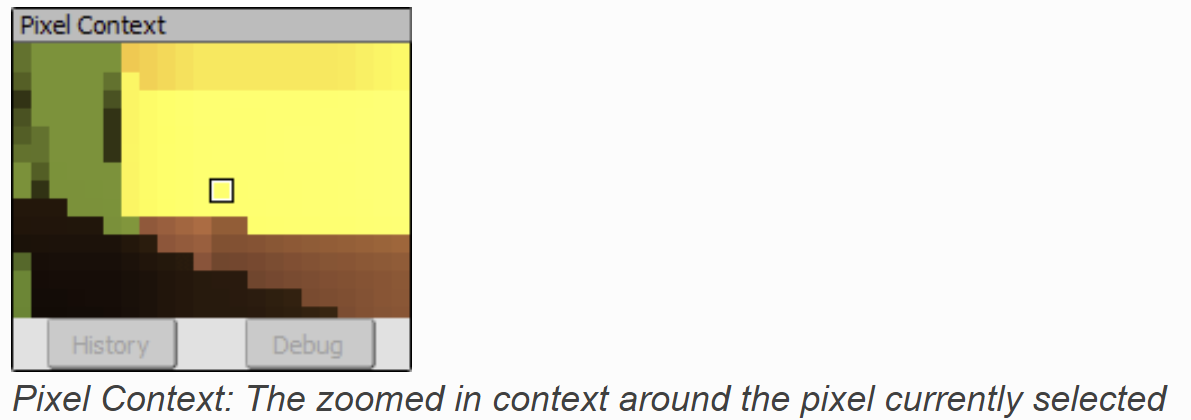
Pixel History
How do I view a specific texture?
Annotating resources with names
Texture list in Texture Viewer
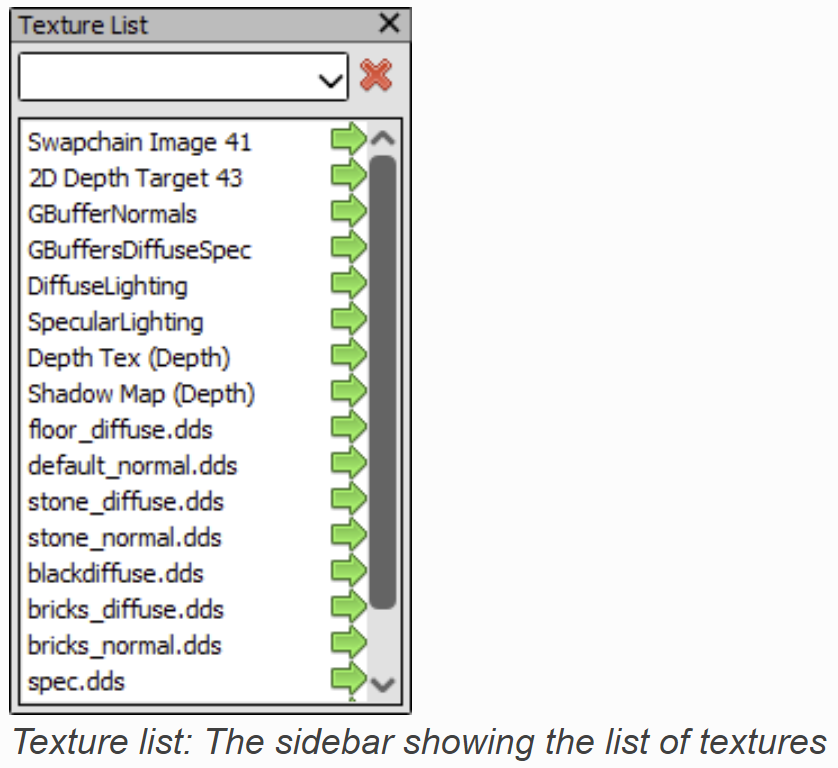
Locked tab of a Texture
How do I view details of an object?
The pipeline state viewers allows you to view more details of given resources that are bound to the pipeline. The go arrow is a sign that more details for this resource are available
is a sign that more details for this resource are available
Resources that are written in bold text with a  are clickable links that lead to the Resource Inspector with more information about a given resource.
are clickable links that lead to the Resource Inspector with more information about a given resource.
Viewing Shaders
Viewing Textures
Viewing Buffers
Viewing Constant Buffers
How do I capture callstacks?
How do I use a custom visualisation shader?
How do I edit a shader?
How do I capture and replay over a network?
How do I annotate a capture?
How do I import or export a capture?
How do I generate an RGP profile?
How do I write a python extension?
How do I control the replay?
Texture Viewer
API Insepctor
Buffer/Mesh Viewer
Capture Dialog
Event Browser
The Event Browser is the primary method of browsing the frame and selecting different drawcalls. It displays the user-annotated hierarchical display of sections
Annotating your frame
Selecting available columns
Timing drawcalls
To time the GPU duration of each drawcall, click the timer button 
This will automatically run a process to get the time of each drawcall and display it in the duration column, which will be added if necessary.
You can configure which time unit is used for the duration column on the fly in the Settings Window
To examine more GPU counters than just plain duration, see Performance Counter Viewer.
Browsing the frame
The event browser is the primary way to browse through the frame. Events are listed as entires in the browser and the hierarchical labels mentioned become tree nodes
The current selected event is highlighted and indicated with a green flag 
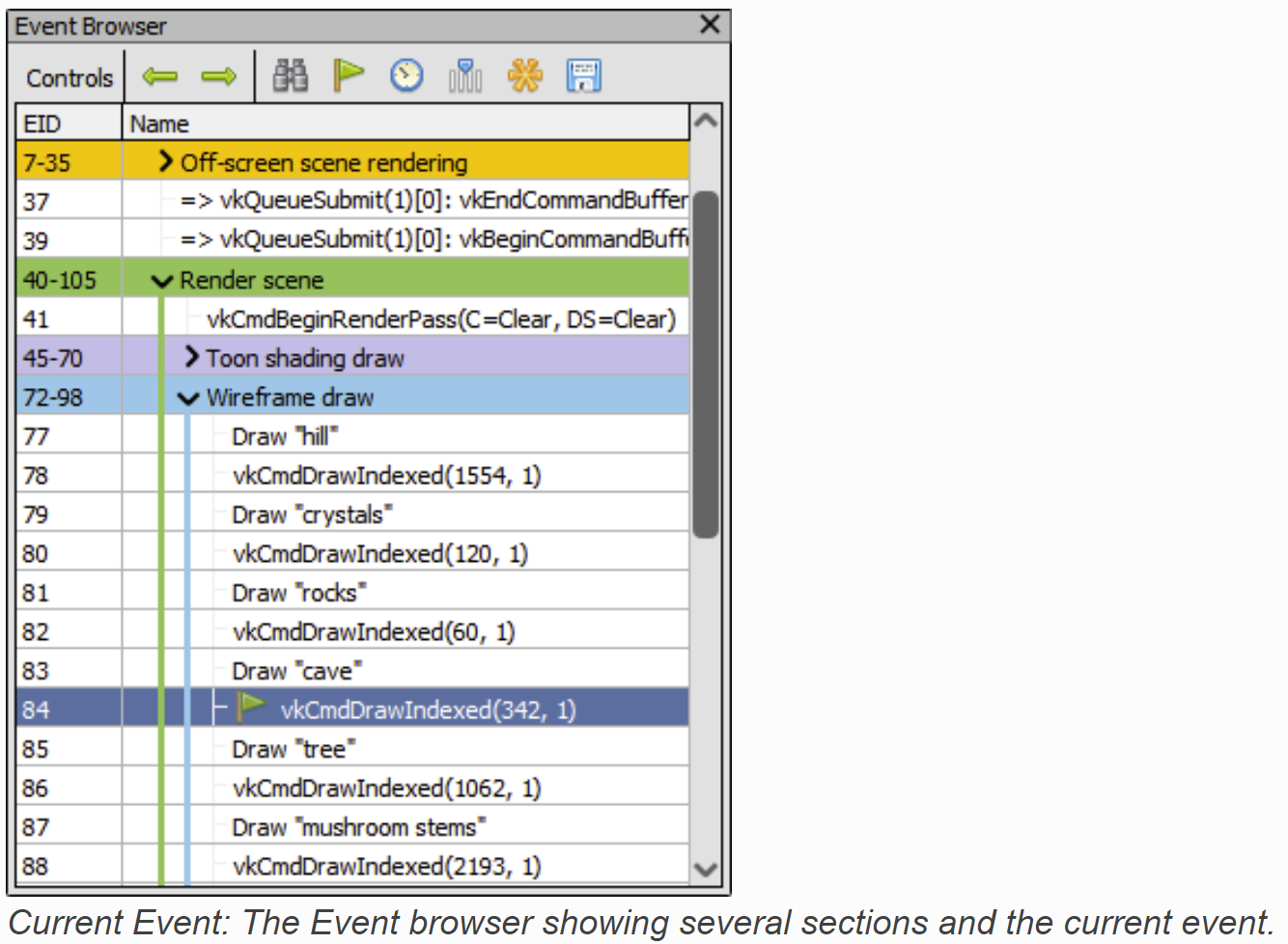
The EID column indicates the event ID of the drawcall listed. Event IDs are assigned starting from 1 and increase every time and API call is made - for this reason drawcall EIDs are not necessarily contiguous.
Simply clicking on a different event will select it as current, and selecting a parent node with some child events will acts as if the final child is selected - in other words selecting a node with serveral children will show the results of all children having happend.
Bookmarks
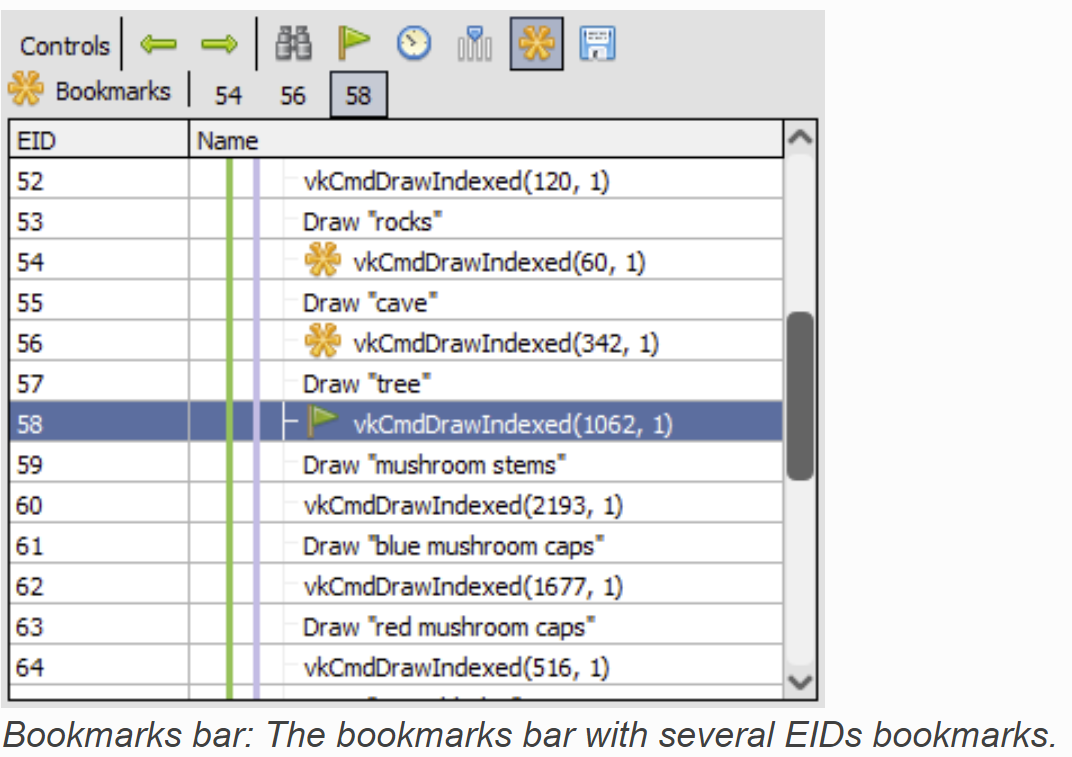
Searching and Jumping
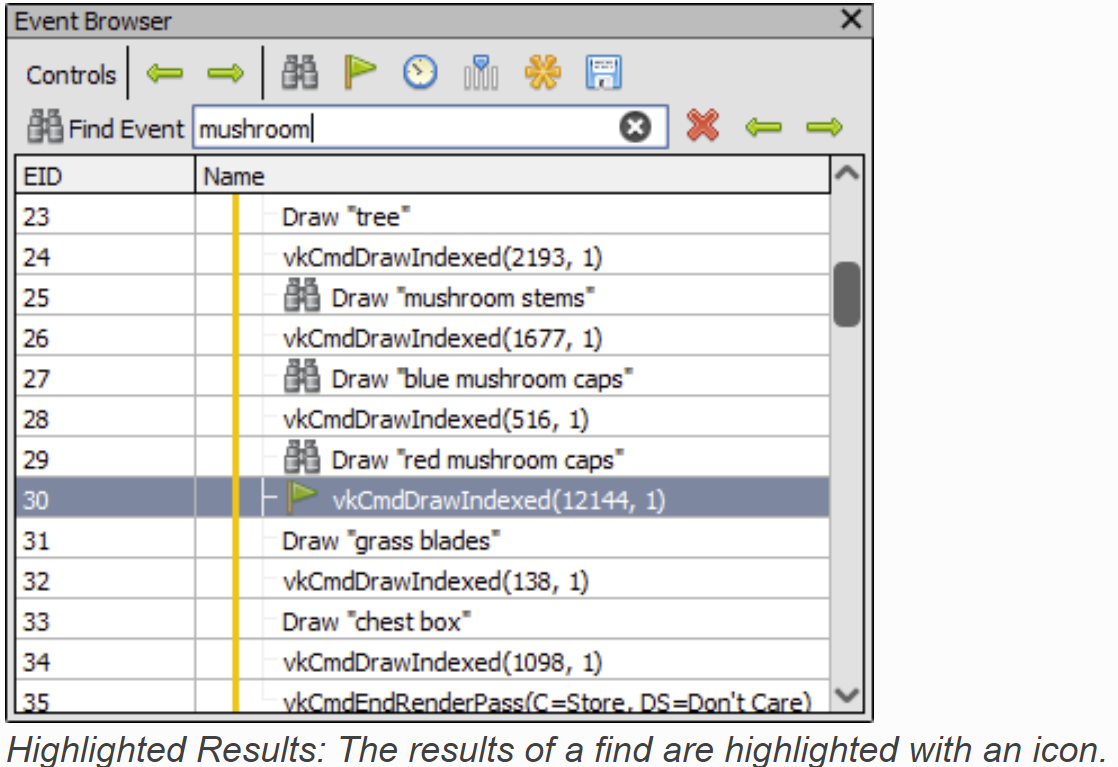

Settings Window
Pipeline State
The Pipeline Viewer is an information dense but simple window in RenderDoc. It shows all of the stateful settings of the graphics pipeline, including bound resources, rasterize settings, etc.
Pipeline flowchart
At the top of the Pipeline Viewer is the pipeline flowchart - this shows the high-level block level diagram of the graphics pipeline
Each block is a separate page which contain the relevant state and contents for that piece of the graphics pipeline, with specific details varying by API and the type of data to be displayed
The currently selected block is outlined with red, and the page in view reflects the contents of that section of the pipeline. Light gray parts of the pipeline are those which are currently active and participating in this drawcall. Dark gray parts of the pipeline are not enabled and can be considered pass-through/do-nothing.

Pipeline Section Display
The pipeline state viewer always displays the state of the pipeline after the execution of the drawcall, as with the other viewers in RenderDoc
Any reousrces that are bound to the pipeline can be opened in more detailed viewers, such as vertex buffers, constant buffers and textures.
The pipeline view attempts to only show what is relevant, and not all possible stateful data. To do this(when available) it uses shader reflection data to only display slots which are actually in use by the shaders, and omit any that are unused.This can be overridden with the Show Unused Items button.
Shader Viewer

Timeline Bar
Capture Connection
Debug Messages
Python Shell
Resource Insepctor
Performance Counter Viewer
The performance counter viewer providers a very simple way to fetch the results of GPU counters across all events in a capture
Counter selection
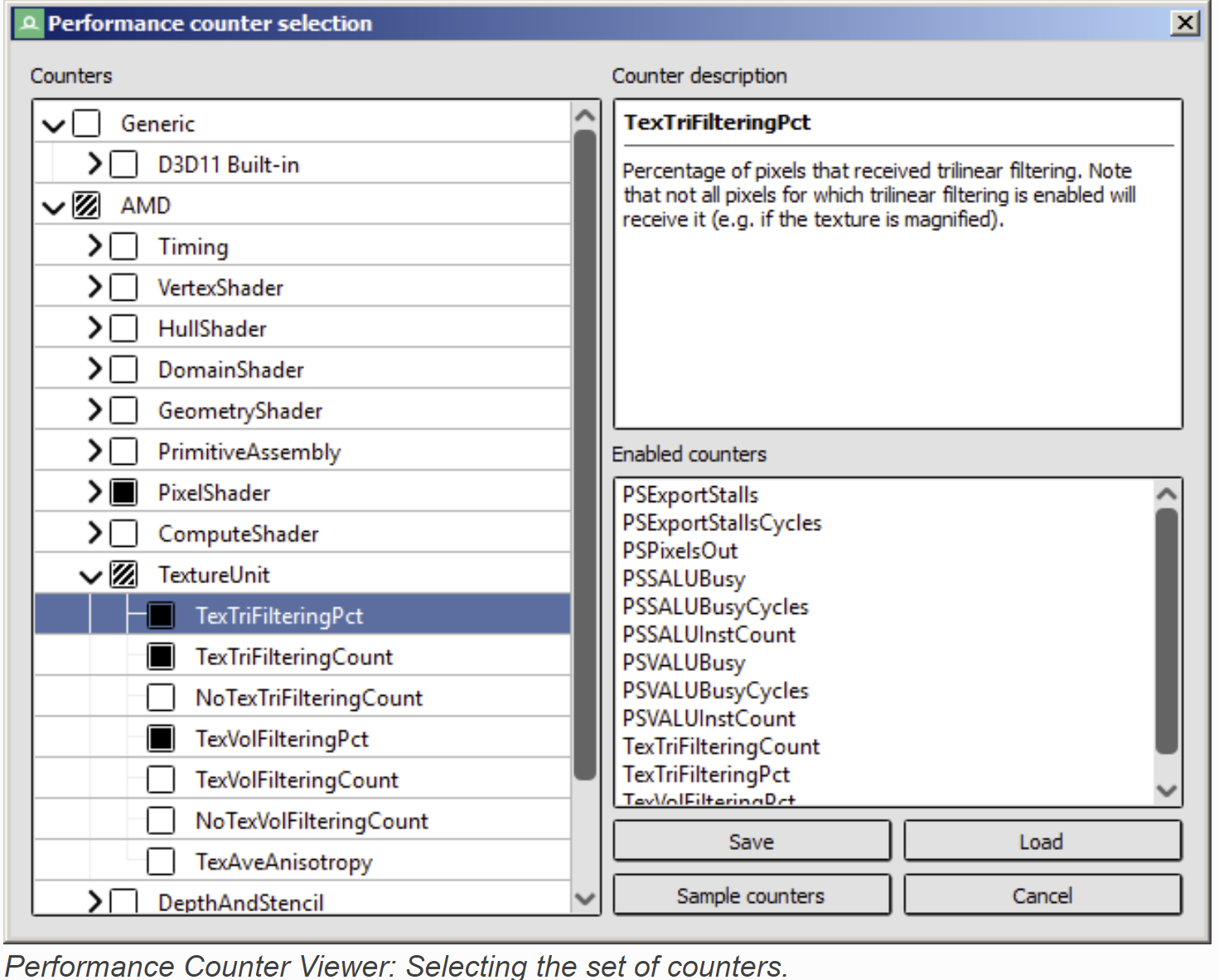
Counter Results

Hardware Counters
Capture Comments
Unity3D\2D手机游戏开发 学习的更多相关文章
- Unity3d/2d手机游戏开发第二版 (金玺曾) 随书资源
http://pan.baidu.com/s/1c0xpn4s Unity3d2d手机游戏开发配书资源文件.rar 1.36G 书上的链接坏掉了,我在论坛上面买了一份,放这分享给买了书找不到资源的同学 ...
- Android——Cocosd2d-x手机游戏开发学习思路
手机APP应用如雨后春笋般冒了出来,而在众多的APP应用中,游戏占据了半壁江山.它丰富着人们的业余生活,增进了人们之间的沟通交流.也有许多开发的朋友对游戏开发情有独钟,他们不止是享受着有很多的人们去下 ...
- Photon + Unity3D 线上游戏开发 学习笔记(一)
大家好. 我也是学习Photon + unity3D 的新手 有什么说错的地方大家见谅哈. 我的开发环境是 unity3D 4.1.3 , Visual Studio 是2010 版本号的 p ...
- Photon + Unity3D 线上游戏开发 学习笔记(四)
这一节 我们建立 photon Server 端的框架 一个最简单的Photon框架 就包括一个 Applocation 类 和 一个 peer 类,作用例如以下: * Application 类是 ...
- Photon + Unity3D 线上游戏开发 学习笔记(三)
好的,说了两篇了 如今我们正式的入手,揭开photon 的盖头哈 建立photon项目 第一步: 在Visual studio建立一个空的 待会为了測试也会在里面建立一个client 项目 (只 ...
- 学习手机游戏开发的两个方向 Cocos2d-x 和 Unity 3D/2D,哪个前景更好?
如题! 首先说一说学习手机游戏(移动游戏)这件事. 眼下移动互联网行业的在以井喷状态发展.全球几十亿人都持有智能终端设备(ios android),造就了非常多移动互联网创业机会: 一.移动社交 微信 ...
- 从一点儿不会开始——Unity3D游戏开发学习(一)
一些废话 我是一个windows phone.windows 8的忠实粉丝,也是一个开发者,开发数个windows phone应用和两个windows 8应用.对开发游戏一直抱有强烈兴趣和愿望,但奈何 ...
- Unity3D手机游戏开发
<Unity3D手机游戏开发> 基本信息 作者: 金玺曾 出版社:清华大学出版社 ISBN:9787302325550 上架时间:2013-8-7 出版日期:2013 年8月 开本:16开 ...
- Android安卓手机游戏开发
成都传智播客Java培训,免费学Android安卓手机游戏开发,安卓android开发课程包括Android安卓应用开发和Android安卓游戏开发两个方向,可是偏向游戏开发. 依据"199 ...
随机推荐
- MicroBlaze核的串行接口实验:SPI UART
reference : https://blog.csdn.net/weixin_42413559/article/details/80720566 串行接口:SPI UART XPS->SDK ...
- 自动化测试工具Telerik Test Studio发布R1 2019|附下载
Telerik Test Studio是一个用于功能性Web.桌面和移动测试的直观测试自动化工具,它能轻松地实现自动化测试.同时会为GUI.性能.加载和API测试提供完整的自动化测试解决方案. [Te ...
- spring4全注解web项目demo
记得没接触框架的时候,写demo测试时真的很爽,新建web项目,然后随便写写servlet随便调试 框架越来越多,配置记不得了,整合容易出问题,集成新东西越来越少了,不敢动了. 这是个spring4的 ...
- WinPcap是用于网络封包抓取的一套工具
WinPcap是用于网络封包抓取的一套工具,可适用于32位的操作平台上解析网络封包,包含了核心的封包过滤,一个底层动态链接库,和一个高层系统函数库,及可用来直接存取封包的应用程序界面. Winpcap ...
- zabbix 监控java通用
监控工具 jstat jstack http://www.blogjava.net/jjshcc/archive/2014/03/05/410655.html https://www.cnblogs. ...
- 点击li ,父辈出现; 子级,子辈不出现. prevUntil ---> 前面多个, 截止到 截止元素 , prev([expr]) --> 前面一个.
要求: 1. 点击第一级 [1知识点] 的时候, [1知识点] 前有 圆圈. 点击 第二级 [1-1知识点, 1-2知识点, 1-3知识点] 时 , [1知识点]出现 圆圈. 2. 点击 第一级 ...
- ios中scrollView基本用法
设置scrollView内容的尺寸(滚动的范围) self.scrollView.contentSize = CGSizeMake(, ); self.scrollView.contentSize = ...
- 1--Testng功能简介
https://www.yiibai.com/testng/parameterized-test.html
- 2--Jmeter 4.0--Excel 数据驱动 接口测试
Excel 模板 通过jmeter的csv data set config 读取 Jmeter注意事项 (1)数据驱动 1..JDBC :SQL 存储在excel中,无法将where条件对应的jmet ...
- Popover 弹出框 设置top,显示有时是向下的,解决方式
参数里面有个popper-options,官网给的值是{boundariesElement: 'body', gpuAcceleration: false },将这个加上问题就解决了.
